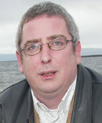Coastal New Particle Formation: A Review of the Current State-Of-The-Art
Colin D. O’Dowd A C and Thorsten Hoffmann BA Department of Experimental Physics & Environmental Change Institute, National University of Ireland, Galway, University Road, Ireland.
B Johannes Gutenberg-Universität Mainz, Institut für Anorganische und Analytische Chemie, Duesbergweg 10-14, 55128 Mainz, Germany.
C Corresponding author. Email: colin.odowd@cmas.demon.co.uk

Colin O’Dowd’s research focuses on aerosol formation and transformation, aerosol–cloud interactions and impacts of aerosols on climate change and air quality. He is based at the Department of Experimental Physics and the Environmental Change Institute at the National University of Ireland, Galway. He is joint Editor-in-Chief of the Journal of Geophysical Research – Atmospheres and is Associated Editor of the International Journal of Oceans and Oceanography. He is currently Co-Chair of the International Committee on Nucleation & Atmospheric Aerosols and is Chair of the American Geophysical Union Technical Committee and Aerosols and Clouds. In 2004 he was awarded the Smoluchowski Award for achievements in atmospheric aerosol research. |

Thorsten Hoffmann is Professor of Analytical Chemistry at the University of Mainz. His research focuses on atmospheric chemistry of biogenic VOCs, formation of secondary organic aerosols from hydrocarbon oxidation and iodine oxides and chemical aerosol characterization of aerosol species. In particular, the research focuses on development of new analytical techniques for aerosol chemical analysis. He is Associated Editor of the Journal of Geophysical Research – Atmospheres and Atmospheric Chemistry and Physics. |
Environmental Chemistry 2(4) 245-255 https://doi.org/10.1071/EN05077
Submitted: 27 September 2005 Accepted: 21 October 2005 Published: 8 December 2005
Environmental Context. Atmospheric aerosols play an important role in determining the earth’s radiative budget, climate change and air quality levels. Much effort has been spent on quantifying the impact of aerosols on climate change; however, the largest gap in our knowledge relates to quantifying natural aerosol systems and the new particle formation process associated with these systems. The marine aerosol system is of particular interest due to the 70% ocean coverage of the earth’s surface. Coastal new particle formation events are though to be more frequent and of stronger intensity compared with open ocean events and thus have been studied in detail to identify possible processes leading to open ocean new particle production.
Abstract. New particle formation via secondary gas-to-particle conversion processes over the oceans is one of the main mechanisms controlling the marine aerosol number population; however, despite extensive effort over the years, this phenomenon is still not well quantified. Coastal new particle formation events are more frequent than open ocean events and consequently have been studied in greater detail. This review article summarizes the recent studies into coastal new particle formation events and summarizes the linkage of these events to iodine emissions and ultimate particle formation via iodine oxide nucleation processes. The current state of knowledge may be summarized by concluding that, in general, coastal nucleation events are driven by biogenic emissions of iodine vapours that undergo rapid chemical reactions to produce condensable iodine oxides leading to nucleation and growth of new particles. The primary source of the condensable iodine vapours is thought to be molecular iodine (I2). The role of iodine oxides in open-ocean new particle production still remains an open question and is the most pressing next step to undertake.
Keywords. : aerosol nucleation — algae — iodine oxides — marine aerosol — organoiodine compounds
Acknowledgments
The authors acknowledge for Science and Engineering Technology (IRCSET) and European Commission under contract EVK-CT-2001-00127 (QUEST).
[1]
R. J. Charlson,
J. E. Lovelock,
M. O. Andreae,
S. G. Warren,
Nature 1987, 326, 655.
| Crossref | GoogleScholarGoogle Scholar |
| Crossref | GoogleScholarGoogle Scholar |
| Crossref | GoogleScholarGoogle Scholar |
| Crossref | GoogleScholarGoogle Scholar |
| Crossref | GoogleScholarGoogle Scholar |
| Crossref | GoogleScholarGoogle Scholar |
| Crossref | GoogleScholarGoogle Scholar |
| Crossref | GoogleScholarGoogle Scholar |
| Crossref | GoogleScholarGoogle Scholar |
| Crossref | GoogleScholarGoogle Scholar |
| Crossref | GoogleScholarGoogle Scholar |
| Crossref | GoogleScholarGoogle Scholar |
| Crossref | GoogleScholarGoogle Scholar |
| Crossref | GoogleScholarGoogle Scholar |
| Crossref | GoogleScholarGoogle Scholar |
| Crossref | GoogleScholarGoogle Scholar |
| Crossref | GoogleScholarGoogle Scholar |
| Crossref | GoogleScholarGoogle Scholar |
| Crossref | GoogleScholarGoogle Scholar |
| Crossref | GoogleScholarGoogle Scholar |
| Crossref | GoogleScholarGoogle Scholar |
| Crossref | GoogleScholarGoogle Scholar |
| Crossref | GoogleScholarGoogle Scholar |
| Crossref | GoogleScholarGoogle Scholar |
| Crossref | GoogleScholarGoogle Scholar |
| Crossref | GoogleScholarGoogle Scholar |
| Crossref | GoogleScholarGoogle Scholar |
| Crossref | GoogleScholarGoogle Scholar |
| Crossref | GoogleScholarGoogle Scholar |
| Crossref | GoogleScholarGoogle Scholar |
| Crossref | GoogleScholarGoogle Scholar |
| Crossref | GoogleScholarGoogle Scholar |
| Crossref | GoogleScholarGoogle Scholar |
| Crossref | GoogleScholarGoogle Scholar |
| Crossref | GoogleScholarGoogle Scholar |
| Crossref | GoogleScholarGoogle Scholar |
| Crossref | GoogleScholarGoogle Scholar |
| Crossref | GoogleScholarGoogle Scholar |



